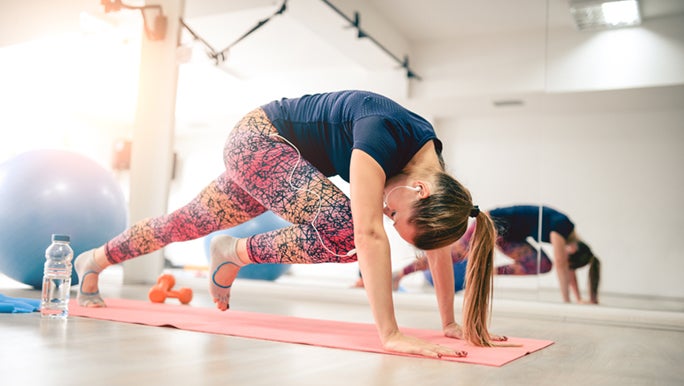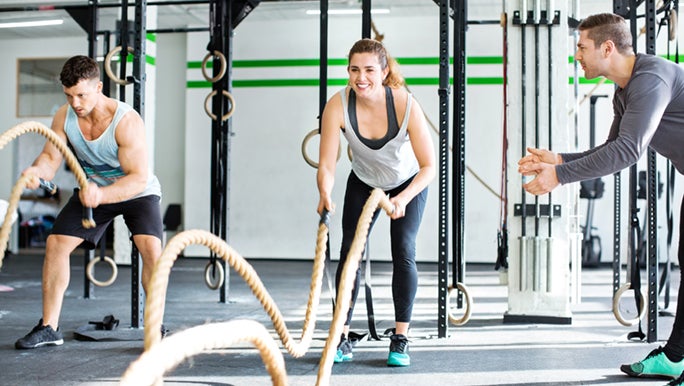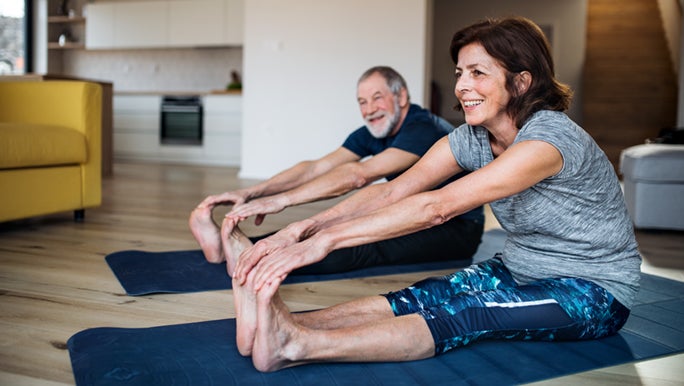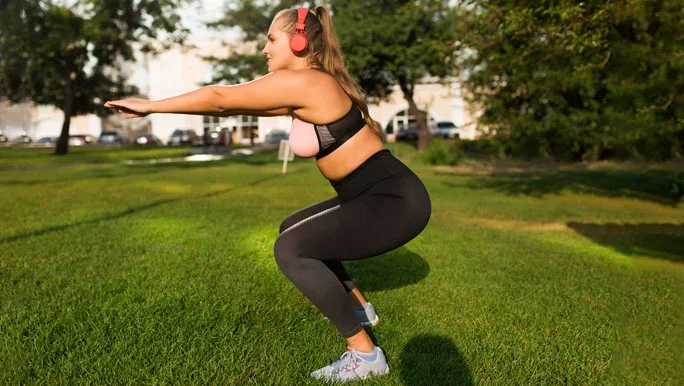Key Points
- Functional training replicates the activities you do in everyday life.
- Functional training exercises generally use more than one muscle group and don’t need large pieces of equipment.
- Simple functional exercises to start with include planks, goblet squats and step ups.
Have you ever considered the muscles you use when you stand up from the couch? Or which muscles you need to engage when you lift the kids and swing them around the room? You expect the muscles you need will just do their thing. And when they don’t, you end up becoming very good friends with a heat pack for your back pain. Ouch!
All exercise has a purpose. Whether it’s a barre stretch class, high altitude training, yoga or even incidental exercise, you exercise for a reason. Maybe it’s for fitness. Perhaps it’s for fun. Or toning. Or health.
But there’s one type of exercise that personal trainer Gabrielle Petterwood is a big fan of – functional training.
“Functional training is great,” she explains, “It’s about trying to replicate things we do in everyday life.”
Intrigued? Here’s the lowdown on functional training and how you could incorporate it into your fitness routine.
What is functional training?
Lifting boxes. Carrying your kids to the car. Standing up from the floor. Hanging washing on the line. All these activities use various muscles in the body. Fairly straightforward, right?
Gabrielle says that functional sports training is so good because it reflects the muscles you use in everyday movements and activities.
“The movements are generally more free flowing rather than structured body building type things,” she explains, “It’s more challenging as the functional training exercises incorporate full body movements rather than just isolating certain muscle groups. That’s typically not how we use our muscles in everyday life.”
While the exercises might be challenging, Gabrielle says they’re also more fun. If you’re wondering how to get motivated to exercise as you ease into fitness, fun and functional training might be the way to go.

Functional training workouts focus on the muscles you use everyday.
Why functional training?
You’re aware of the health benefits of walking and benefits of running. You might even have tried yoga poses for digestion. But what is it that makes functional training so beneficial?
A functional training system may enhance things like:
- speed
- muscular strength
- power
- balance
- agility
Some evidence suggests that functional strength training has benefits for older people. Researchers found that older people who do functional training may see beneficial impacts in their daily activities. These activities include things such as vacuuming, rising from a chair or climbing stairs.
Perhaps the biggest benefit, as Gabrielle says, is the functional exercises you do may translate directly into everyday life.

There are many pieces of equipment you can use for your functional training.
Functional fitness training equipment
Whether you’ve got a gym membership or you’re working out in your at-home gym, the equipment you need is the same.
Gabrielle says that any one piece of equipment you could use for a variety of different movements is always good. She suggests the following:
- weighted slam balls
- boxes for steps ups of box jumps
- resistance bands for various exercises
If you have a fitness tracker you could also track your workout. Depending on the capability of your tracker you may be able to see the calories you’ve burned, your heart rate or the muscle groups you’ve worked.

“A strong core is important for everyday living and movements.” says our PT.
4 functional training exercises to incorporate into your workouts
How much exercise you should do per day, how often you should go to the gym or what type of exercises you should do really depends on you. But if you’re keen to incorporate functional training into your routine, Gabrielle suggests four key exercises to get you started.
1. Plank
Gabrielle says that a plank uses muscles in the whole body, even your pelvic floor. It’s also a fun exercise for kids to try.
“It’s great for strengthening the core,” she explains, “A strong core is important for everyday living and movements.”
How to: Lay on the floor and position your elbows under your shoulders with your forearms on the ground. Bring your toes and heels together before popping up onto your toes. Brace your core (think ribs to hips), squeeze your glutes and retract your shoulders. Ensure your hips aren’t piked or sagging.
2. Barbell deadlift
An exercise that works your posterior chain and your core.
“Deadlifts are important for strengthening the glutes, hamstrings, abdominals, erector spinae, rhomboids and traps,” says Gabrielle, “These muscles all work together to support the spine to lift the weight safely and efficiently.”
How to: Hold the bar close to your body. Hinge from your hips, maintaining a strong core and a neutral spine while lowering the bar to the ground. When extending at the top of the movement, punch through the hips before pushing the hips back into the hinge and lowering the bar back down to the ground.
3. Goblet squat
Because the weight is held anterior (i.e., at the front of your body), Gabrielle says this is a movement that utilises your glutes, quads, calves, hamstrings and core.
How to: To perform a goblet squat you need to have a stable base. Your feet should be hip width apart, your shoulders retracted and your core braced.
As you lower your body, your hips move backwards, as you would if you were to sit on a chair. At the bottom of the squat, engage and drive through the glutes to end in hip extension (standing tall). Throughout the movement, watch for your knees collapsing in and/or shifting too far forwards.
4. Step up
Gabrielle says that step ups are beneficial because they use unilateral strength to stabilise you as you step up onto a higher surface.
“Step ups engage the core, glutes, quads, calves and hamstrings,” explains Gabrielle, “This movement is great for building up lower body strength and stamina.”
How to: To perform a step up correctly, ensure the working leg is on a stable surface. As you step upwards, drive the weight through your heel and midfoot and engage your glute.
Keep your core engaged throughout the movement to ensure your hip is stable. Once full hip extension is achieved at the top of the step, reverse the movement slowly.

The key to your workout - make it fun!
Fun and functional
If you struggle with motivation, keep your workouts fun. Whatever exercise you’re doing, whether it’s a functional training workout or a floor exercise video, don’t forget about the benefits of stretching. Fun and functional for the win!
Related:
Gabrielle Petterwood is a Personal Trainer with a holistic approach to fitness, nourishing the body with fresh foods and living a healthy and balanced lifestyle to realise full body health.
Reviewed by the healthylife Advisory Board December 2021.




